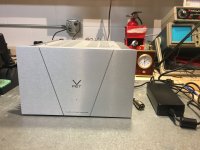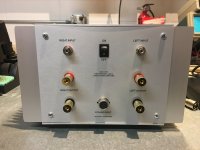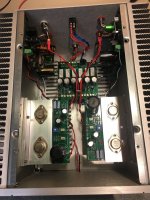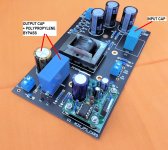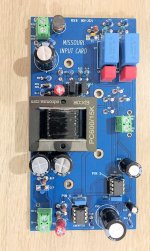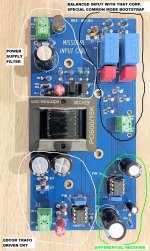I finished my 2SK60 VFET part 3 amplifier today, it's been playing music for hours now. I have the Theseus PSFLT and Nimitz FE with Tucson daughter boards from my M2X build. I also have Austin, and Mountain View to try out later. Dead quiet and sounds awesome! Has to be the easiest amp to set bias!
No turn on or off thumps with Mark Johnson's designed PSFLT set to 5 seconds. The only changes I made were using Nichicon capacitors since the Panasonic caps were on back order. I did use mica and goop instead of the silicone pads provided in the OS kit and Nichicon LKG Type 3 (Super Through) output caps on the Nimitz FE (I had them in stock). The DPDT rocker switch is from Mouser (P/N 629-GRS-4022-0021) and the DC input connector is a Tajima 3 pin locking ring I found at Misumi USA.
Many thanks to Jason, Gianluca, Mark Johnson and of course Nelson!
No turn on or off thumps with Mark Johnson's designed PSFLT set to 5 seconds. The only changes I made were using Nichicon capacitors since the Panasonic caps were on back order. I did use mica and goop instead of the silicone pads provided in the OS kit and Nichicon LKG Type 3 (Super Through) output caps on the Nimitz FE (I had them in stock). The DPDT rocker switch is from Mouser (P/N 629-GRS-4022-0021) and the DC input connector is a Tajima 3 pin locking ring I found at Misumi USA.
Many thanks to Jason, Gianluca, Mark Johnson and of course Nelson!
Attachments
Moderator and hellof-a-good-guy 6L6 predicted that builders would really enjoy auditioning their already-built M2x input cards in the VFET amp, therefore Nimitz would be popular. He also predicted that builders wouldn't be able to resist the temptation to substitute different, possibly boutique, capacitors at input and output. Because Nimitz provides such big PCB footprints -- yer forced to!
_
_
Attachments
Absolutely a wonderful platform for experimenting with lots of different parts and stages! Nimitz is an excellent addition to the already incredible range of input stages for Vfet/Theseus amplifiers.
Genuinely one of my favorites.
Genuinely one of my favorites.

Since Mark and 6L6 where the last to comment, I’ll ask the pros.
Real world advantage to Enig vs Hasl? Bigger difference for PS boards, small signal boards, or output boards? Mage difference on something like the FE boards where you might be tempted to switch parts later to play with sound (hold up to desolated/solder).
Just got a pair of 2SJ18s so time to build/order some boards from JLCPCB. At minimum need TUBA and hornet FE.
Real world advantage to Enig vs Hasl? Bigger difference for PS boards, small signal boards, or output boards? Mage difference on something like the FE boards where you might be tempted to switch parts later to play with sound (hold up to desolated/solder).
Just got a pair of 2SJ18s so time to build/order some boards from JLCPCB. At minimum need TUBA and hornet FE.
I am interested in both your Front End board for this amp and the revised Power Supply filter. Any idea when these might be available in the DIY store?Very small.
I have decided to forge ahead with a Sony VFET OS2 P channel build. I have received two 2sj18’s, a 4U chassis, the P channel build kit from DIY store, and the Meanwell power supply. I have on order the Scourge front end, and Mark Johnson’s PS filter parts from the recommended parts houses and board suppliers. Not sure about another front end at this point. Would be nice to use the Missouri as my pre-amp has balanced outputs. Thinking simple build with a Scourge FE kit is a good starting point.
Thanks to NP and all of you fearless amp builders for helping me enter into this DIY hobby. My ACA‘s were challenging, fun to build and you all here in the community are an inspiration to forge on.
Thanks to NP and all of you fearless amp builders for helping me enter into this DIY hobby. My ACA‘s were challenging, fun to build and you all here in the community are an inspiration to forge on.
You are in for a treat. The VFET P channel is a wonderful amp. I also like the Scourge front end.


Would be nice to use the Missouri as my pre-amp has balanced outputs. ... ... thinking simple build with a Scourge FE kit is a good starting point.
Here's the Missouri balanced input card. I wouldn't call it a terrifying mountain of infinite complexity.
The quad of input capacitors (primary + bypass) are at upper right (2xBlueBox & 2xRedBox).
_
Attachments
Hmm, well that certainly looks doable. Thanks Mark.
I note that in the block diagram that there is a Power supply filter block on the board. If one uses this board does one need to use the stand alone PSU filter kit that you designed?
Looks like I will be putting together another order. Thanks so much for your efforts on our behalf.
I note that in the block diagram that there is a Power supply filter block on the board. If one uses this board does one need to use the stand alone PSU filter kit that you designed?
Looks like I will be putting together another order. Thanks so much for your efforts on our behalf.
You don’t technically need the PSU filter on any of these builds, but I’d strongly recommend one of the versions that has the relay to mute the power on and/or off thumps. Mark’s Theseus PS filter is what I’m using in my build, and I really want to try the Tuba filter in the near future.
The nice thing about the filters is if there’s any SMPS weirdness from your brick, the filters will catch it and filter it away. I’ve been experimenting with really, really cheap power bricks to determine a) how bad the cheap bricks are, which is highly variable but some of them are pretty ugly, and b) how much the filters make a difference on the nasty bricks, and that answer is “an amazing amount” of positive change due to the filter. (Of course, starting with a very clean brick/PSU like a MeanWell is obviously preferable, and the filters still make a positive difference!)
But anyway, just build the TheseusPS in the time being and experiment with others if you want in the future.
The nice thing about the filters is if there’s any SMPS weirdness from your brick, the filters will catch it and filter it away. I’ve been experimenting with really, really cheap power bricks to determine a) how bad the cheap bricks are, which is highly variable but some of them are pretty ugly, and b) how much the filters make a difference on the nasty bricks, and that answer is “an amazing amount” of positive change due to the filter. (Of course, starting with a very clean brick/PSU like a MeanWell is obviously preferable, and the filters still make a positive difference!)
But anyway, just build the TheseusPS in the time being and experiment with others if you want in the future.
Last edited:
The power supply filter that's on its own PCB and sits on the chassis floor, removes noise created by the MeanWell switchmode PS brick. This much-cleaner DC supply is provided to the other four PCBs within the chassis: FrontEnds left+right, and AmpChannels left+right.
The two AmpChannel PCBs, containing obsolete, expensive, and difficult to find VFET devices, greatly benefit from having much-cleaner DC power. Less crud on the AmpChannel's power supply means less crud passed along to the loudspeaker. Same goes for the Theseus MOSFET amp channel boards: less crud on the power supply means less crud passed along to the loudspeaker.
Removing the supply filter PCB from the floor of the chassis, would do a great disservice to the AmpChannel PCBs. It would rob them of much-cleaner DC power. And the resulting amplifier would not sound nearly as good as its blood brother that does contain a supply filter PCB. Conclusion: The amp channel boards need the power supply filter PCB, don't take it out. Nelson Pass put it in for a good reason. I agree with his thinking and my Theseus PSFILT is a direct descendant of his original design, with a couple slight embellishments.
Repeat after me: the amp channel boards need the power supply filter PCB. No matter which Front End cards you have installed. Whether you've chosen Missouri, Lexington, Marauder, or the rare and esoteric "Relentless" Front End cards -- you need and want a power supply filter PCB.
The two AmpChannel PCBs, containing obsolete, expensive, and difficult to find VFET devices, greatly benefit from having much-cleaner DC power. Less crud on the AmpChannel's power supply means less crud passed along to the loudspeaker. Same goes for the Theseus MOSFET amp channel boards: less crud on the power supply means less crud passed along to the loudspeaker.
Removing the supply filter PCB from the floor of the chassis, would do a great disservice to the AmpChannel PCBs. It would rob them of much-cleaner DC power. And the resulting amplifier would not sound nearly as good as its blood brother that does contain a supply filter PCB. Conclusion: The amp channel boards need the power supply filter PCB, don't take it out. Nelson Pass put it in for a good reason. I agree with his thinking and my Theseus PSFILT is a direct descendant of his original design, with a couple slight embellishments.
Repeat after me: the amp channel boards need the power supply filter PCB. No matter which Front End cards you have installed. Whether you've chosen Missouri, Lexington, Marauder, or the rare and esoteric "Relentless" Front End cards -- you need and want a power supply filter PCB.
Last edited:
Thanks for the explanation. My boards from JLCPCB. are on the way as evidently are the parts from Mouser and Digi-Key. I should have lots of boxes land on my doorstep in the next few days….
Sorry for this stupid question…too much time on my hands while I entertain wife on vacation and think about parts shipments arrival
Is it possible to bridge any of the single ended VFET OS designs and use them as monoblocks with a single front end card?🤔
Is it possible to bridge any of the single ended VFET OS designs and use them as monoblocks with a single front end card?🤔
single FE?
not made, for my knowledge
though, as with any (read F4 manual), feed it with XLR and from stero amp you have bridged monoblock


not made, for my knowledge
though, as with any (read F4 manual), feed it with XLR and from stero amp you have bridged monoblock


Just finished my build with 2SK82 and was doing some measurement to confirm operation. I don't recall seeing any distortion spectrum published. When I see 3rd harmonic higher than 2nd, I'm a bit surprised. Is this normal?
Running at 1.6A bias and 14V at Mosfet drain as documented. +V at VFET is just above 33V.


Running at 1.6A bias and 14V at Mosfet drain as documented. +V at VFET is just above 33V.
- Home
- Amplifiers
- Pass Labs
- DIY Sony VFETs OS2 Official thread
